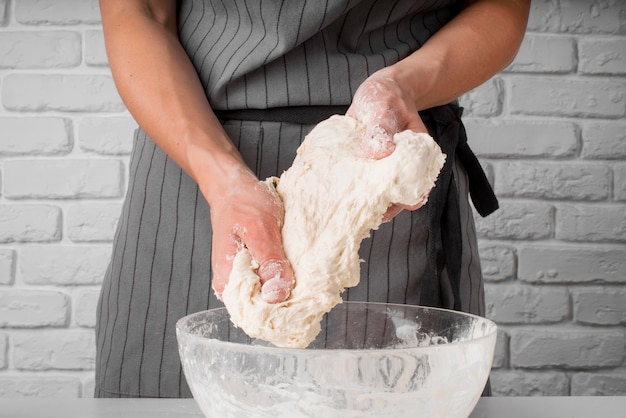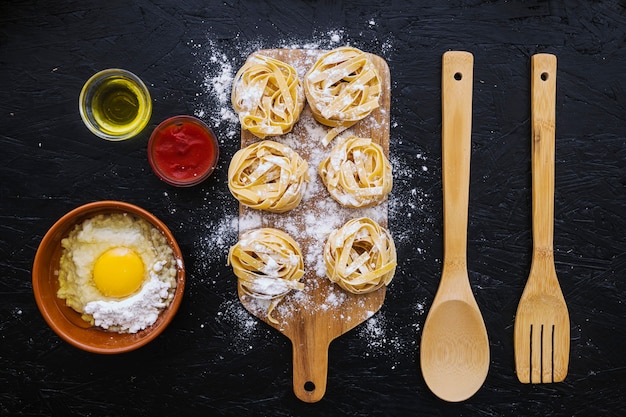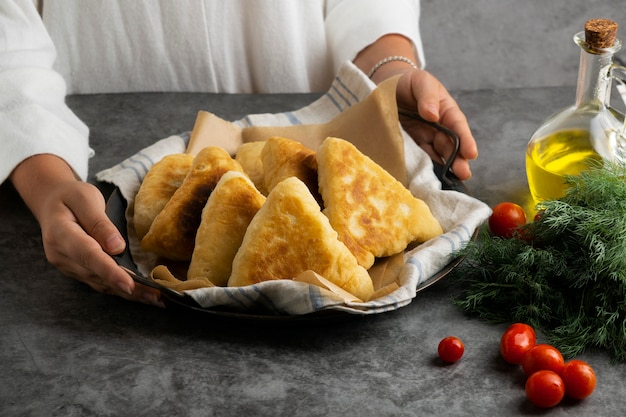Remember those little parcels of pure deliciousness, ravioli? For years, I thought making them at home was some sort of culinary wizardry, something reserved for Michelin-starred chefs. But I discovered it's actually quite straightforward, and let me tell you, the taste is heavenly, miles better than anything you'd get in a restaurant. So, let's embark on a ravioli-making adventure together. This isn't just about making ravioli, it's about understanding the magic that happens when you combine simple ingredients and create something truly special.
(Part 1) The Dough: The Foundation of Your Ravioli

The first step is making the dough. It's the foundation of your ravioli, so it needs to be perfect. The good news is it's not as scary as it seems. You'll need some basic ingredients: flour, eggs, a pinch of salt, and a good dose of elbow grease. That's it!
Choosing the Right Flour: The Key to a Silky Smooth Dough
The type of flour you use makes a world of difference. I've experimented with different types, and for me, a mix of 00 flour and plain flour works best. 00 flour is really fine, which gives the dough a lovely smooth texture. It's like the silky smooth base of a delicious dessert, but for savoury bites. Plain flour adds structure and keeps the dough from being too delicate. It's like a good supporting actor, quietly doing its job to make sure the main event shines.
Kneading the Dough: A Workout for Your Hands
Now, it's time to knead the dough. This is where you really get to feel the magic of making pasta. Grab that dough ball and get ready to give it a good work out. Imagine it's a grumpy old cat that needs a good kneading. A bit of force is needed to get that gluten happy. It'll take about 10 minutes to get it to a smooth and elastic consistency. You'll feel the dough become supple and strong, ready to be rolled out.
Resting the Dough: Patience is a Virtue
You've done the hard work, so now it's time to let the dough relax. Wrap it in cling film and give it a good hour in the fridge. This allows the gluten to relax, making the dough more manageable for rolling. It's like giving a hard-working muscle a chance to recover and be ready for action.
(Part 2) Rolling Out the Dough: The Art of Thinness

After your dough has had its beauty sleep, it's time to bring out the rolling pin. Now, I'm not talking about those flimsy ones that bend at the slightest pressure. You need a sturdy one, the kind that makes you feel like you're in control. And here's a little secret: flour is your friend. Dust your work surface and the dough liberally with flour to prevent sticking. It's like giving your dough a little powder puff treatment.
Roll out the dough until it's as thin as a sheet of paper, almost translucent. Think about a fine silk scarf, the kind you imagine on a glamorous woman. You'll need to roll it in stages, gradually increasing the pressure on the rolling pin. It's like a dance, where you move slowly and surely, building momentum until you achieve the perfect thickness. The key is to be patient and persistent.
(Part 3) Cutting the Dough: A Matter of Precision

Now, you've got a beautiful sheet of dough, and it's time to cut it into squares. This is where your ravioli-making skills really come into play. Grab a ruler, a sharp knife, and a steady hand. Measure out your squares, making them about 3-4 inches, or a bit bigger if you want to make some really generous ravioli. Remember, the more dough you have, the more filling you can stuff in, which is always a win in my book.
Now, here's a tip. Instead of cutting with a knife, you can use a ravioli cutter or even a cookie cutter. It's like a little ravioli party in your kitchen. These tools will ensure uniformity and save you time.
(Part 4) Filling the Ravioli: The Heart of the Matter
Now comes the fun part: filling the ravioli. Get ready to get creative. You can use traditional fillings like ricotta cheese and spinach, or go wild with something more adventurous like roasted butternut squash and sage, or even a spicy sausage filling. Remember, your filling is like the heart of the ravioli, so make sure it’s a flavour bomb.
Once you've chosen your filling, the next step is to put it on the dough. Place a small dollop of filling in the center of each square, leaving a little space around the edges. Don't overfill the ravioli; you want to make sure they seal properly.
Balancing Flavors: The Art of Filling
When choosing your filling, consider the flavour profile you want to achieve. Do you want something creamy and rich? Or perhaps something bright and vibrant? The possibilities are endless. For example, if you're using a ricotta and spinach filling, you might want to add a touch of nutmeg or a squeeze of lemon juice for extra flavour.
(Part 5) Sealing the Ravioli: A Gentle Embrace
Now, it's time to bring your ravioli together. This is where you need to channel your inner artist. You want to create a seal that's strong enough to hold the filling in but not so tight that it squishes the filling out. I like to use a fork, pressing down along the edges of the dough, creating a little border that looks like a fancy little fence. It's like a gentle embrace, holding the filling safe and sound.
Alternative Sealing Techniques: Exploring Different Options
There are other ways to seal your ravioli too. You can use a rolling pin to press down on the edges, or you can even use a special ravioli mold, which can give you really beautiful, perfectly shaped ravioli. Whatever method you choose, the important thing is to make sure those edges are sealed tight. A good seal will prevent the filling from escaping during cooking.
(Part 6) Cooking the Ravioli: A Short, Sweet Dance
Finally, it's time to cook your ravioli. Now, the key here is to boil the ravioli for just a few minutes. Overcooking will make them mushy, and nobody wants that. Bring a large pot of salted water to a boil, then gently drop your ravioli into the water. You want to be careful not to overcrowd the pot. Think of it as a dance floor, give everyone enough space to move around and cook evenly. A few minutes later, your ravioli will be ready.
The Importance of Boiling Time: Mastering the Art of Timing
The boiling time for ravioli depends on the thickness of the dough and the size of the ravioli. As a general rule, you'll want to boil them for about 3-5 minutes, or until they float to the surface. Overcooked ravioli will be mushy, while undercooked ravioli will be raw. The goal is to achieve that perfect al dente texture.
(Part 7) Serving the Ravioli: A Feast for the Senses
You've reached the final stage, and it's time to celebrate your culinary masterpiece. Your ravioli are now ready to be devoured. You can serve them with a simple sauce, like a tomato sauce or a creamy pesto sauce. Or, you can go all out with a more elaborate sauce, like a truffle sauce or a mushroom ragu. It's entirely up to you.
My Favourite Ravioli Toppings: A Symphony of Flavors
For me, I like to keep it simple with a classic butter and sage sauce. The combination of the buttery richness and the earthy flavour of sage is simply divine. A sprinkle of grated parmesan cheese is the finishing touch, adding a touch of salty goodness. But remember, it's your creation, so experiment and find what you love best!
(Part 8) FAQs: Answering Your Burning Questions
Now, let's get to your burning questions about making ravioli:
- What if my dough is too sticky?
If your dough is too sticky, it's probably because you've added too much water. Just add a little more flour, a tablespoon at a time, until the dough is no longer sticky. You want it to be smooth and slightly elastic.
- How do I know if the ravioli are cooked?
The ravioli are cooked when they float to the surface of the water. This usually takes about 3-5 minutes.
- Can I freeze ravioli?
Absolutely! To freeze ravioli, place them on a baking sheet lined with parchment paper and freeze them for about 30 minutes. Once they're frozen, transfer them to an airtight container or freezer bag. You can freeze ravioli for up to 3 months. To cook frozen ravioli, simply drop them directly into boiling water without thawing. Just add a couple of minutes to the cooking time.
- How can I make ravioli ahead of time?
You can definitely make your ravioli ahead of time. Just make the dough and fill the ravioli as instructed. Then, place them on a baking sheet lined with parchment paper, and freeze them for about 30 minutes. Once they're frozen, transfer them to an airtight container or freezer bag. You can store the frozen ravioli for up to 3 months. To cook frozen ravioli, simply drop them directly into boiling water without thawing. Just add a couple of minutes to the cooking time.
- What are some other filling ideas for ravioli?
The beauty of ravioli is that you can get creative with your fillings. Here are some ideas to inspire you:
- Ricotta and Spinach:
A classic for a reason. The creamy ricotta and earthy spinach are a match made in heaven.
- roasted butternut squash and Sage:
A bit more adventurous, but equally delicious. The sweetness of the butternut squash is perfectly balanced by the savoury sage.
- Spicy Sausage Filling:
For those who like a bit of heat, this is a great option. Use your favourite sausage, and add some chopped bell peppers and onions for extra flavour.
- Mushroom and Parmesan:
A rich and flavorful filling that is perfect for a hearty meal.
- Prosciutto and Fig:
A sweet and savory combination that is sure to impress. Use thin slices of prosciutto and ripe figs for a delicious filling.
- Pea and Mint:
A light and refreshing filling that is perfect for summer. Use fresh peas and mint for a vibrant and flavourful dish.
- Lobster and Cream:
A luxurious filling that is perfect for a special occasion.
(Part 9) A Final Word
If your dough is too sticky, it's probably because you've added too much water. Just add a little more flour, a tablespoon at a time, until the dough is no longer sticky. You want it to be smooth and slightly elastic.
The ravioli are cooked when they float to the surface of the water. This usually takes about 3-5 minutes.
Absolutely! To freeze ravioli, place them on a baking sheet lined with parchment paper and freeze them for about 30 minutes. Once they're frozen, transfer them to an airtight container or freezer bag. You can freeze ravioli for up to 3 months. To cook frozen ravioli, simply drop them directly into boiling water without thawing. Just add a couple of minutes to the cooking time.
You can definitely make your ravioli ahead of time. Just make the dough and fill the ravioli as instructed. Then, place them on a baking sheet lined with parchment paper, and freeze them for about 30 minutes. Once they're frozen, transfer them to an airtight container or freezer bag. You can store the frozen ravioli for up to 3 months. To cook frozen ravioli, simply drop them directly into boiling water without thawing. Just add a couple of minutes to the cooking time.
The beauty of ravioli is that you can get creative with your fillings. Here are some ideas to inspire you:
- Ricotta and Spinach:
- roasted butternut squash and Sage:
- Spicy Sausage Filling:
- Mushroom and Parmesan:
- Prosciutto and Fig:
- Pea and Mint:
- Lobster and Cream:
A classic for a reason. The creamy ricotta and earthy spinach are a match made in heaven.
A bit more adventurous, but equally delicious. The sweetness of the butternut squash is perfectly balanced by the savoury sage.
For those who like a bit of heat, this is a great option. Use your favourite sausage, and add some chopped bell peppers and onions for extra flavour.
A rich and flavorful filling that is perfect for a hearty meal.
A sweet and savory combination that is sure to impress. Use thin slices of prosciutto and ripe figs for a delicious filling.
A light and refreshing filling that is perfect for summer. Use fresh peas and mint for a vibrant and flavourful dish.
A luxurious filling that is perfect for a special occasion.
So, there you have it. Making ravioli is not as intimidating as it seems. With a little patience and a bit of elbow grease, you can create something truly special. Now, go out there, get your hands dirty, and enjoy the magic of homemade ravioli. You'll be surprised at how easy it is to make these little parcels of joy. Happy ravioli-making!
Remember, this isn't just about following a recipe, it's about embracing the process and discovering what brings you joy in the kitchen. So, get creative, experiment, and enjoy the journey!
And if you find yourself with any more questions along the way, don't hesitate to ask! There's a whole world of ravioli out there waiting to be explored.
Everyone is watching

Corn on the Cob: The Ultimate Guide to Perfectly Cooked Ears
Healthy MealsAh, corn on the cob. Just the name evokes images of sunny days, barbecues, and that sweet, juicy flavour that ...

Perfect Pork Roast Oven Cooking Time: A Guide to Delicious Results
Healthy MealsThere's something truly satisfying about a perfectly roasted pork. The aroma alone is enough to make your mout...

Ham Cooking Time: How Long to Bake, Smoke, or Boil a Delicious Ham
Healthy MealsAh, ham. It's a classic, isn't it? A real crowd-pleaser, especially around holidays. And when done right, it'...

Scallops: The Ultimate Guide to Perfect Cooking
Healthy MealsAh, scallops. Those delicate, sweet, and utterly delicious morsels of the sea. They hold a special place in my...

Spaghetti Squash: The Ultimate Guide to Cooking and Serving
Healthy MealsRemember that time you saw spaghetti squash at the supermarket, looking all bumpy and strange, and thought, "W...
